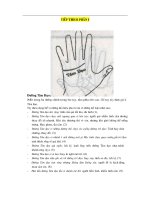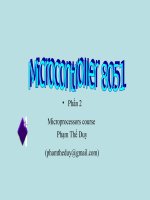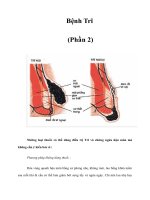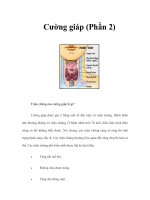Tài liệu Water desalination - Phần 2 docx
Bạn đang xem bản rút gọn của tài liệu. Xem và tải ngay bản đầy đủ của tài liệu tại đây (374.68 KB, 30 trang )
24
3
Key Technological and Scientific Issues for Desalination
In order to meet the long-term objectives for cost reduction and wider applicability of
desalination identified in the Roadmap, innovative ideas will need to be developed and
nurtured. The Roadmap and recommendations made in this report should not restrict
investment in emerging ideas and technologies but should instead serve to stimulate
creative thinkers to apply their expertise and knowledge to achieve the goal of improving
desalination and water purification processes and considerably lowering their costs.
Five technology areas are identified in the Roadmap: membranes, thermal
technology, alternative technologies, concentrate management, and reuse and recycling.
These areas clearly point in the right direction, although the environmental, economic,
and social costs of energy for desalination should be included within an additional cross-
cutting research area. According to one example provided in the Roadmap, electrical
power accounts for 44 percent of the costs of reverse osmosis of seawater (USBR and
SNL, 2003), although the exact costs will vary with plant size or the cost of electricity.
The impacts of energy use will need to be examined for desalination plants to become
more widely used.
While research and technological developments continue to reduce the costs of
desalinated water by optimizing performance, additional cost reductions may be more
difficult to achieve, especially as many current systems are already operating at high
efficiencies. This chapter discusses the technological and scientific issues for
desalination, according to the five technological areas in the Roadmap. For each
technology area, the cost issues and technical opportunities for contributing to
desalination are described, and the projects identified in the Roadmap are reviewed.
Missing topics that deserve further study are presented, and some research areas are
suggested to be deleted. Research topics proposed in the Roadmap that were considered
appropriate are not discussed at length; thus, the amount of discussion on individual
projects should not be viewed as a reflection of the panel’s priorities. These suggested
revisions to the research areas itemized in the Roadmap for each of the technology areas
are summarized in Tables 3-1 through 3-6.
Copyright © National Academy of Sciences. All rights reserved.
Review of the Desalination and Water Purification Technology Roadmap
/>Key Technological and Scientific Issues for Desalination 25
MEMBRANE TECHNOLOGIES
Semi-permeable membranes can be used to selectively allow or prohibit the passage
of ions, enabling the desalination of water. Over the last 40 years, tremendous
advancements have been made in the field of membrane technologies. In fact, reverse
osmosis (RO) represents the fastest growing segment of the desalination market, and as
of 2002, RO represented 43.5 percent of the capacity of all desalination plants greater
than 0.026 mgd, approximately equal to the thermal desalination capacity (Wangnick,
2002). As noted in the Roadmap, “membranes are expected to play critical roles in
formulating future water supply solutions.” Membrane technologies can be used for
desalination of both seawater and brackish water, but they are more commonly used to
desalinate brackish water because energy consumption is proportional to the salt content
in the source water. Membrane technologies have the potential to contribute to water
supplies through their use in treating degraded waters in reuse or recycling applications
since membrane technology can remove microorganisms and many organic contaminants
from feed water. Compared to thermal distillation processes, membrane technologies
generally have lower capital costs and require less energy, contributing to lower
operating costs. However, the product water salinity tends to be higher for membrane
desalination (<500 ppm TDS) than that produced by thermal technologies (25 ppm
TDS) (USBR, 2003a).
Membrane technologies for desalination and water purification typically operate
under one of two driving forces: pressure or electrical potential. The following pressure-
driven membrane technologies are commercially available for treating impaired waters in
a range of applications (Lee and Koros, 2002) (Figure 3-1). In addition to understanding
the removal capabilities of the membrane process, it is important to note the typical
pressure driving force ranges and separation mechanisms, because it can affect their
power consumption.
• Reverse osmosis (RO) membranes are used for salt removal in brackish and
seawater applications. RO membranes have also been shown to remove
substantial quantities of some molecular organic contaminants from water
(Sedlak and Pinkston, 2001; Heberer et al., 2001). RO removes contaminants by
solution diffusion
4
and operates under a trans-membrane pressure difference in
the range of ~ 5 – 8 MPa.
• Nanofiltration (NF) membranes are used for water softening (removing
primarily divalent cations), organics and sulfate removal, and some removal of
viruses. NF membranes operate under a trans-membrane pressure difference in
the range of 0.5 – 1.5 MPa. Removal is by combined sieving and solution
diffusion.
• Ultrafiltration (UF) membranes are used for removal of color, higher weight
dissolved organic compounds, bacteria, and some viruses. UF membranes also
operate via a sieving mechanism under a trans-membrane pressure difference in
the range of ~50 – 500 kPa.
4
The solution diffusion theory presumes that both the solutes and water molecules dissolve in the
RO membrane material and diffuse through. Water passes based on pressure, but solute separation
occurs because of a difference in diffusion rates through the RO membrane.
Copyright © National Academy of Sciences. All rights reserved.
Review of the Desalination and Water Purification Technology Roadmap
/>26 Review of the Desalination and Water Purification Technology Roadmap
FIGURE 3-1 Size ranges removed by various membrane types along the filtration spectrum.
SOURCE: Pankratz and Tonner, 2003.
• Microfiltration (MF) membranes are used for turbidity reduction and removal of
suspended solids and bacteria. MF membranes operate via a sieving mechanism
under a trans-membrane pressure difference in the range of ~50 – 500 kPa.
Electrodialysis is another membrane-based process that is important to desalination,
which operates under a different driving force, applying an electrical potential to
motivate ions in opposite directions to produce an ion-depleted and ion-enriched stream
in each cell pair.
• Electrodialysis (ED) is the separation of the ionic constituents in water through
the use of electrical potential and cation- and anion-specific membranes. In ED
applications, hundreds of positively and negatively charged cell pairs are
assembled in a stack to achieve a practical module (Lee and Koros, 2002;
Strathmann, 1992).
Electrodialysis reversal (EDR) operates according to the same principles, but periodically
reverses the polarity of the system to reduce scaling
5
and membrane clogging.
Electrodialysis represents approximately three percent of worldwide desalination capacity
(Wangnick, 2002).
Summary of Cost Issues
Desalination costs associated with the reverse osmosis process have markedly
declined in recent years (Figure 1-6). These cost reductions have occurred through
economies of scale and improvements in membrane technology (e.g., increased salt-
5
Scaling is the deposition of mineral deposits on the interior surfaces of process equipment or
water lines as a result of heating or other physical or chemical changes.
Copyright © National Academy of Sciences. All rights reserved.
Review of the Desalination and Water Purification Technology Roadmap
/>Key Technological and Scientific Issues for Desalination 27
rejection, flux rate, and longevity), energy recovery devices, and reduced material costs.
Considering the recent improvements in membrane-based desalination, substantial further
cost savings could be more difficult to achieve, suggesting the need for a carefully
developed research agenda targeted to areas that offer the most promise for cost
reduction. The Roadmap provides an example of the cost breakdown for seawater
desalination by RO that suggests that the largest cost reduction potential lies in capital
costs (fixed charges) and energy (Figure 3-2). Continued improvements in membrane
materials, permeability, and energy recovery devices could generate additional cost
reductions. Substantial savings could also arise from improvements or simplifications to
pretreatment systems for membrane desalination, since capital and operating costs for
reverse osmosis pretreatment can represent more than 50 percent of the overall cost of a
reverse osmosis system (Pankratz and Tonner, 2003).
The Roadmap proposes long-term critical objectives of 50–80 percent reduction in
capital and operating costs and an increase in energy efficiency of 50–80 percent. For
membrane-based desalination facilities, these energy goals will not be possible with
advances in existing membrane technology alone. A simplified but fundamental example
can illustrate the hard limits that the technology, as it is currently practiced, is
encountering. Production of a purified stream of permeate water typically involves a
permeate recovery ratio (the fraction of feedwater passing through the membrane) much
less than 100 percent. The salt concentration increases in the water that does not pass
through the membrane (the concentrate) and requires even more driving force to produce
the next increment of product water as higher permeate recovery ratios are achieved.
Given the mechanical limits of membranes and the desire to avoid excessive pressure, the
permeate recovery ratio is typically limited to 50 percent or less for seawater feeds (Wilf
and Klinko, 1997). As an example, in a RO seawater system operating at 50 percent
feedwater recovery, flux rate of 8.5 gallons per square foot per day (gfd), with a 34,000
ppm TDS seawater feed at 22ºC, the required feed pressure will be about 65 bar (940
psi). If the system would utilize a 100 percent efficient pumping and energy recovery
FIGURE 3-2 Cost structure for a reverse osmosis desalination of seawater. SOURCE: USBR and
SNL, 2003.
Copyright © National Academy of Sciences. All rights reserved.
Review of the Desalination and Water Purification Technology Roadmap
/>28 Review of the Desalination and Water Purification Technology Roadmap
FIGURE 3-3 Typical reverse osmosis membrane desalination system with energy recovery.
unit, the minimum energy consumption would be 6.7 kWh/1000 gal (1.77 kWh/m
3
).
6
A
typical RO system with energy recovery is illustrated in Figure 3-3. Current state-of-the-
art seawater RO systems under similar conditions can operate at 8.4 kWh/1000 gal
(Andrews et al., 2001); an 80 percent reduction would result in 1.7 kWh/1000 gal, which
is not a realistic goal for standard RO technology. Such energy recovery approaches
provide, at best, the ability to operate at the thermodynamic efficiency limit. Based on
the above 6.7 kWh/1000 gal limit, this would represent a maximum optimistic reduction
of 20 percent.
7
To obtain further reductions in energy, a different desalination approach
is required, such as the targeted ability to remove only impurities from the water, rather
than passage of all of the purified water across the membrane.
The Roadmap correctly states that, as noted above, technology breakthroughs could
result in more efficient membrane technologies that would remove only the specific
target contaminants from the water stream. This targeted removal has attractive aspects
in many cases with a well-defined feed stream containing known impurities. The lower
6
This value—the energy required for high pressure pumps for reverse osmosis of seawater, E
ro
—
was calculated as E
ro
=K*P
f
/(Eff
hyd
*Eff
mot
*R) -E
rec
, where K is a unit conversion factor, P
f
is the
calculated feed pressure, Eff
hyd
is the pump hydraulic efficiency, Eff
mot
is the pump motor
efficiency, R is the system recovery ratio (assumed here to equal 0.5), and E
rec
is the energy
recovered through an energy recovery turbine. The required feed pressure was calculated with the
above stated parameters for a multi-element membrane unit using the software package IMS by
Hydranautics, which assumes the performance of commercial seawater membranes. The value for
E
rec
= K*P
c
*Eff
t
*(1-R)/(Eff
mot
*R), where P
c
is the pressure of the concentrate stream, and Eff
t
is
the energy recovery turbine efficiency. Assuming 100 percent efficiencies and no frictional losses
in the system (so that P
f
= P
c
), the equations can be combined into E
ro
=K*P
f
. Actual RO operations
would require additional energy to power the necessary pretreatment and auxiliary equipment.
7
Similar estimates are also derived by consideration of fundamental thermodynamic calculations
based on free energies for typical feed, permeate and concentrate streams.
Copyright © National Academy of Sciences. All rights reserved.
Review of the Desalination and Water Purification Technology Roadmap
/>Key Technological and Scientific Issues for Desalination 29
operating pressures possible with such an approach would also result in lower operating
costs.
8
Selective contaminant removal would reduce the amount of mass of chemicals in
the concentrate that then must be properly disposed. However, this approach runs the
risk of not producing as pure a water product, since unrecognized contaminants that are
not targeted for removal may remain in the treated water. This aspect is a significant
public health concern when dealing with degraded waters from diverse sources.
Review of Research Directions
The membrane research areas and projects identified in the Roadmap for improving
the efficiency and cost of desalination are appropriate but incomplete. The Roadmap
identifies a significant portion of the research areas critical to improving membrane
technologies in desalination. However, there are some areas that are not included in the
Roadmap, and some of the existing topics should be expanded. The table of research
topics included in the Roadmap has been modified (Table 3-1) to highlight these missing
topics and summarize the suggested revisions.
Sensor Development/Membrane Integrity
To address the “national need” of providing safe water, the project to develop an on-
line viral analyzer should be expanded to include pathogens as a broader definition of
potentially harmful biological contaminants in water. The integrity of the membranes
and membrane system is also a critical research area that should be included. Even a tiny
area of defects in the membrane surface of an otherwise perfect barrier to pathogens can
allow a number of organisms to pass across the barrier into the product water. In cases
involving long storage time, some non-parasitic organisms could multiply to an unsafe
level of pathogens in the product water. Integrity verification of RO/NF membranes is
expected to become an important issue in the future as potential sources of water for
desalination (including seawater) are facing contamination by municipal and agricultural
discharge.
Tailorable Membrane Selectivity
In order to ensure sustainability and adequate water supplies, it is important to
develop the ability to design in selectivity as well as permeability. Tailorable membrane
selectivity would facilitate reliable removal of specific contaminants if and when they are
identified in a given source water. This technology would enable undesirable
components to be removed at some acceptable cost in terms of permeability and
contribute to water supply and reuse options.
Membrane Fouling
Efforts to mitigate membrane fouling should be expanded to include the development
of fouling-resistant elements and systems and appropriate indicators of fouling.
8
Since RO/NF operation is based on applying pressure higher than the osmotic pressure difference
between the feed and the permeate, if only selective ions are rejected, the osmotic pressure of the
permeate is closer to the osmotic pressure of the feed; thus, lower feed pressures would be
required for the same permeate flux rate.
Copyright © National Academy of Sciences. All rights reserved.
Review of the Desalination and Water Purification Technology Roadmap
/>30 Review of the Desalination and Water Purification Technology Roadmap
Membranes can be fouled by any number of organic or inorganic materials, including
microbial biomass, such as algae or bacteria. Harsh cleaning agents decrease the life of a
membrane element and contribute significantly to membrane system operating costs.
Therefore, the development of fouling-resistant membrane surfaces and elements would
be beneficial, leading to longer membrane life spans and reduced operating costs from
both cleaning and pretreatment to reduce fouling. Given widely different feed water
qualities and membrane configurations, it would be difficult to develop a membrane
surface that is completely resistant to all types of fouling; thus, module restoration will
also be necessary. Therefore, improved methods of cleaning and restoring fouled
membrane modules rather than disposing of them is an important priority for research.
Membrane Operating Costs
Reduction of operating and maintenance costs is imperative to the goal of reducing
the costs of desalination. Specifically, reducing the use of pre- and posttreatment
chemicals and improving cartridge filter design in order to reduce replacement rate are
two areas for potential cost savings related to membrane processes. The selection of
pretreatment methods is based on the feedwater quality, membrane material, module
configuration, recovery, and desired effluent quality (Taylor and Jacobs, 1996). It would
be advantageous to reduce the need for pretreatment by improving the membrane
materials or configuration, including the use of backwashable MF or UF as prefilters.
For example, advances in membrane configurations could improve the hydrodynamics of
the system by increasing the cross-flow velocity or introducing dean vortices in the
module to minimize concentration polarization and thus the need for removal of
particulates upstream of the module (Belfort et al., 1994). Posttreatment is an important
cost component and should also be addressed. RO- and NF-treated permeate tends to be
corrosive because of reduced pH, calcium, and alkalinity. The corrosive tendency of
desalted water can be reduced by the addition of lime or soda ash and/or by the addition
or removal of CO
2
. The amount of chemicals added for posttreatment can be reduced by
developing membranes with selective ion rejection (e.g., to specifically reduce boron,
which can be hazardous in agricultural applications) or through application of integrated
processes to optimize the overall treatment scheme.
Membrane Process Design
Further reductions in manufacturing costs of membrane desalination facilities should
be explored, such as designing equipment to utilize less expensive materials and
improving configurations to reduce element costs. Membrane process design should
specifically include integrated membrane (Glueckstern et al., 2002) and hybrid
membrane/non-membrane components. Integrated membrane systems utilize two
membrane technologies, either including membrane pretreatment or using two different
membrane types for salinity reduction, thereby improving the efficiency of the plant.
Strategically designed hybrid membrane systems, such as membrane-thermal systems,
may decrease energy consumption and/or control water quality, depending on the quality
of the feedwater (Ludwig, 2003). These membrane/thermal desalination hybrid plants
may offer greater flexibility when determining the final salt content and overall energy
consumption of the system. Opportunities remain for process optimization in integrated
membrane and hybrid desalination systems.
Copyright © National Academy of Sciences. All rights reserved.
Review of the Desalination and Water Purification Technology Roadmap
/>TABLE 3-1 A summary of the committee’s recommendations for research topics for membrane technologies.
National Need ĺ
Technology Area Ļ Provide Safe Water
Ensure Sustainability/
Ensure Adequate Supplies Keep Water Affordable
Membrane
Technologies
• Smart membranes
o Contain embedded sensors
o Disinfection treatment
o 2020: sense contaminant
differential across the
membrane, automatically
change performance and
selectivity
• Sensor development
o Model compounds for
organics
o On-line
viral/pathogen/pyrogen
analyzer
o Micro/in-situ/built-in EPS
sensor to detect biofilms;
particulate fouling sensor
o Integrity verification
• Membrane research
o Completely oxidant resistant
o Operate over a range of pH’s
(enable either
mechanical/chemical
cleaning)
o Adjust removal capability
based on feed water quality
and removal needs (2014—
pharmaceuticals removal
based on molecular weight,
hydrophilicity)
o Biofilm-resistant surfaces
• Develop high integrity membranes
& systems
• Mechanistic/fundamental
approach to membrane design
o CFD of feed channel
o Conduct research to gain
understanding of molecular-
level effects
o Design-in
permeability/selectivity
• Develop understanding of whole
system (based on current
knowledge)
o Develop model of
optimization
o Research sensitivity of
parameters for model
• Develop fundamental
understanding of fouling
mechanisms
o Understand how to mitigate
fouling
- Understand biofouling
- Optimize operational
controls
- Develop fouling
resistant
elements/systems
o Develop indicators for fouling
• Develop performance restoration
of fouled membrane
• Basic research to improve
permeability
o Minimize resistance
o Model/test non spiral
configurations
• Improve methods or develop new
methods of reducing/recovering
energy
• Integrate membrane and
membrane system designs
• Reduce membrane
operating/maintenance costs
o Reduce consumption of
pretreatment and
posttreatment chemicals
o Improve cartridge filter design
to reduce replacement rate
• Reduce manufacturing costs
through design
o Identify or develop less
expensive materials for
membranes and filtration
systems, including corrosion
resistant materials
o Improve configuration to
reduce elements cost
NOTE: These recommendations are presented as revisions to the “research areas with the greatest potential” as identified in the Roadmap. The table has been
reproduced in the same format that appears in the Roadmap, and italicized topics indicate additional promising research areas suggested in this report. SOURCE:
Modified from USBR and SNL, 2003.
Copyright © National Academy of Sciences. All rights reserved.
Review of the Desalination and Water Purification Technology Roadmap
/>32 Review of the Desalination and Water Purification Technology Roadmap
Membrane Bioreactors
An important opportunity for membrane processes in water reuse applications is in
membrane bioreactors (MBRs). MBRs have grown in use and applicability in recent
years, and are now used for municipal and industrial wastewater treatment applications.
Water treated by MBRs routinely meets reuse standards for certain feedwaters (Manem
and Sanderson, 1996; Rittman, 1998); however, further research could increase the
applicability of MBRs to a wider range of feedwater qualities. The long-term operation
of a MBR is a function of the performance of the membranes, which depends on the
membrane material, operational parameters, flux characteristics and module
configuration. This important membrane application is further discussed in the reuse
section of this chapter.
Priorities
Among the membrane technology areas identified in the Roadmap and those
additional areas suggested by this committee (see Table 3-1), several have been identified
as the highest priority research topics within this category. These topics were identified
as those most likely to contribute substantially to the objectives set by the Roadmapping
Team, with regard to improved energy efficiency, reduced operating costs, and high
quality water. The priority topics are:
• Improving membrane permeability (in order to operate at a lower feed pressure
for a given module cost) while improving on or maintaining current salt
rejections.
• Improving or developing new methods for reducing energy use or recovering
energy (e.g., improving the efficiency of high pressure pumps).
• Improving pretreatment and posttreatment methods to reduce consumption of
chemicals.
• Developing less expensive materials to replace current corrosion resistant alloys
used for high pressure piping in seawater RO systems.
• Developing new membranes that will enable controlled selective rejection of
contaminants.
• Improving methods of integrity verification.
• Developing membranes with improved fouling-resistant surfaces.
THERMAL TECHNOLOGIES
Approximately one-half of the world’s installed desalination capacity uses a thermal
distillation process to produce fresh water from seawater. Thermal processes are the
primary desalination technologies used throughout the Middle East because these
technologies can produce high purity (low TDS) water from seawater and because of the
lower fuel costs in the region. Three thermal processes represent the majority of the
thermal desalination technologies in use today.
Copyright © National Academy of Sciences. All rights reserved.
Review of the Desalination and Water Purification Technology Roadmap
/>Key Technological and Scientific Issues for Desalination 33
• Multi-Stage Flash Distillation (MSF) uses a series of chambers, each with
successively lower temperature and pressure, to rapidly vaporize (or “flash”) water
from bulk liquid brine. The vapor is then condensed by tubes of the inflowing feed
water, thereby recovering energy from the heat of condensation. Despite its large
energy requirements, MSF is among the most commonly employed desalination
technologies. MSF is a reliable technology capable of very large production
capacities per unit.
• Multi-Effect Distillation (MED) is a thin-film evaporation approach, where the
vapor produced by one chamber (or “effect”) subsequently condenses in the next
chamber, which exists at a lower temperature and pressure, providing additional heat
for vaporization. MED technology is being used with increasing frequency when
thermal evaporation is preferred or required, due to its lower power consumption
compared to MSF.
• Vapor Compression (VC) is an evaporative process where vapor from the
evaporator is mechanically compressed and its heat used for subsequent evaporation
of feed water. VC units tend to be used where cooling water and low-cost steam are
not readily available. (Pankratz and Tonner, 2003)
Three other thermal techniques—solar distillation, membrane distillation, and freezing—
have been developed for desalination, although they have not been commercially
successful to date (Buros, 2000). In brief, solar distillation uses the sun’s energy to
evaporate water from a shallow basin, which then condenses along a sloping glass roof.
In membrane distillation, salt water is warmed to enhance vapor production, and the
vapor is exposed to a membrane that can pass water vapor but not liquid water. Freezing
technologies use ice formation under controlled conditions in the source water, initially
eliminating salt from the ice crystals and allowing the brine to be rinsed away.
As noted in the Roadmap, thermal seawater distillation processes employed in the
Middle East are mature technologies that may not have broad application in the United
States. While thermal desalination is not expected to displace membrane-based
desalination as the predominate desalination technology in the United States, thermal
technologies have substantial potential and should be considered more seriously than they
have been to date. For example, thermal technologies can be built in conjunction with
other industrial applications, such as electric power generating facilities, to utilize waste
heat and lower overall costs while providing other significant process advantages, such as
high-quality distillate even in seawater applications.
Summary of Cost Issues
Wangnick (2002) notes that energy use represents 59 percent of the typical water
costs from a very large thermal seawater desalination plant (Figure 3-4). The other major
expense comes from capital costs. Thus, cost reduction efforts would be most effective if
they were focused on these areas. For example, research efforts to develop less-costly
corrosion-resistant heat-transfer surfaces could reduce both capital and energy costs. The
most significant cost reduction opportunities for thermal desalination may be found in the
area of energy management by utilizing “new” sources of heat or energy to accomplish
evaporation or through the use of existing energy sources during off-peak periods for
thermal desalination purposes.
Copyright © National Academy of Sciences. All rights reserved.
Review of the Desalination and Water Purification Technology Roadmap
/>34 Review of the Desalination and Water Purification Technology Roadmap
Thermal energy
50%
Capital
32%
Chemicals
3%
Electrical energy
9%
Personnel
6%
FIGURE 3-4 Breakdown of typical costs for a very large seawater thermal desalination plant.
SOURCE: Wangnick, 2002.
As acknowledged in the Roadmap, the lack of centralized water and power planning
in the United States contributes to the high cost of thermal desalination. Yet the
Roadmap seems to dismiss cogeneration plants (combined water and power production),
despite their notably reduced energy consumption, because they are “expensive to build
and operate.” Wider application of cogeneration should be explored further, particularly
as older power plants are replaced or repowered.
Review of Proposed Research Directions
The Roadmap does not develop a research path based on opportunities for improving
thermal technologies, nor does it adequately identify areas of research in thermal
technologies which might help meet the report’s objectives. Overall, the Roadmap’s
Working Group appears to have lacked thermal desalination expertise, and several
misleading statements are made in the Roadmap about thermal desalination. For
example, the report misinforms readers by neglecting to state that the energy requirement
of thermal technologies (“260 kw-hr/1000 gallons – or one quarter of the electricity
consumed by the average house in a month”) can be met by “waste” heat and other low-
grade energy sources. The Roadmap also states that thermal plants produce “more dilute
concentrate waste.” In the case of vapor compression, this is incorrect. In the case of
MSF and MED processes, the concentration factor for thermal and membrane seawater
desalination is very similar, but the overall thermal desalination plant discharge may be
diluted because a significant amount of cooling water may also be discharged with the
concentrate.
The thermal technology research areas and projects identified in the Roadmap are
generally appropriate but could be expanded and in some cases revised. Additional
research on the topic of hybrid technologies is proposed in the Roadmap, although the
rationale is not well described. The Roadmap should emphasize that integrating
membrane and thermal processes with an electric generating station to meet fluctuating
Copyright © National Academy of Sciences. All rights reserved.
Review of the Desalination and Water Purification Technology Roadmap
/>Key Technological and Scientific Issues for Desalination 35
water/power demands improves flexibility and economics. Instead the Roadmap
incorrectly states that hybrid plants “reduce waste streams.”
The discussion below describes some missing research topics that could provide
improvements to thermal desalination technologies. These suggestions are also
summarized in Table 3-2. While the table includes some topics that are more speculative
than others, all of the topics listed in Table 3-2 are deemed to have potential to contribute
to the advancement of thermal technologies.
Evaluate the Benefits of Cogeneration
Virtually all large, non-U.S. seawater desalination plants combine water production
with the generation of electric power using the same fuel source. These “dual purpose
plants” reduce overall costs, since thermal energy from power production can be used
effectively in the desalination process. Efficient cogeneration depends upon an
appropriate ratio of power-to-water production that matches regional demand,
considering seasonal fluctuations and the types of power and desalination technologies
used. Hybrid (thermal and membrane) may offer additional flexibility to reach the
optimal power-water production ratio. Research to evaluate the benefits of integrating
power and water production at power plant sites should be conducted (including case
studies of select existing and future power facilities).
Membrane Pretreatment for Thermal Desalination
Water production in thermal plants is often limited by scaling considerations.
Membrane pretreatment (e.g., nanofiltration to remove scaling constituents such as
calcium and sulfate ions) may allow operation at higher temperature and production rates,
potentially reducing overall costs. Research into cost-effective pretreatment methods
could also be valuable to the overall thermal plant design.
Alternative Energy Sources for Desalination
Most thermal desalination processes have the ability to use low-grade energy or
“waste” heat rather than a primary energy source. The use of alternative energy sources,
which is discussed later in this chapter under “Cross-Cutting Technology-Related
Research,” is a potential area for future research which could result in improved
desalination economics and broader application of desalination.
Cooling Water Alternative
Most thermal seawater desalination processes require large amounts of cooling water
and have significantly greater seawater intake flow rates than comparably sized
membrane systems. The use of innovative cooling systems may reduce the water intake
requirements and allow operation at higher concentration factors, thereby reducing the
pumping costs, reducing the environmental impacts of the water intake process, and
creating a smaller volume of concentrate for disposal.
Heat Transfer Materials
Current heat-transfer surfaces use expensive corrosion-resistant materials (e.g.,
titanium, high-grade stainless steel); thus, research to evaluate or refine nonmetallic or
Copyright © National Academy of Sciences. All rights reserved.
Review of the Desalination and Water Purification Technology Roadmap
/>









